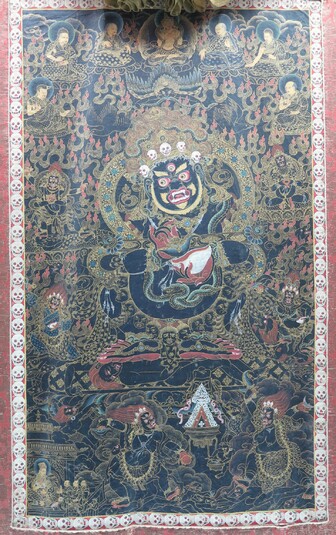
Item: Mahakala (Buddhist Protector) - Panjarnata (Lord of the Pavilion)
| Origin Location | Tibet |
|---|---|
| Date Range | 1500 - 1599 |
| Lineages | Sakya, Ngor (Sakya) and Buddhist |
| Material | Ground Mineral Pigment, Black Background on Cotton |
| Collection | Private |
Panjarnata Mahakala (Tibetan: gur gyi gon po, English: the Great Black One, Lord of the Pavilion). Panjarnata is a protector deity belonging to the class of Mahakala and his special function or activity is to protect the Hevajra Tantra cycle of practices and the devotees. Panjarnata belongs to the class of enlightened protectors and his general demeanour is in Wrathful Appearance one of the Eleven Figurative Forms in Himalayan style art.
panjarata is the special protector of the Hevajra cycle of teachings and principal protector of the Sakya School of Tibetan Buddhism. This form of Mahakala arises from the 18th chapter of the Vajrapanjara exclusive explanatory tantra. The Vajrapanajara Tantra is exclusive to the Hevajra Root Tantra whereas a tantra such as the Samputa is an explanatory tantra shared between the Hevajra and Chakrasamvara (and Yogini) root literature.
"...the great Vajra Mahakala, blazing, with one face, two hands, in the right a curved knife and the left a skullcup filled with blood, held above and below the heart. Held across the middle of the two arms is the 'Gandhi of Emanation.' With three eyes, bared fangs, yellow hair flowing upward, a crown of five dry human skulls and a necklace of fifty wet, blood dripping; adorned with six bone ornaments and snakes; having a lower garment of tiger skin; flowing with pendants and streamers of various silks; in a posture dwarfish and thick, standing above a corpse. To the right is a black crow, left a black dog, behind a wolf, in front a black man, above a garuda, emanations of messengers issue forth, with Akshobhya as a crown, standing in the middle of blazing fire of pristine awareness." (Konchog Lhundrub, 1497-1557).
Lineage of Teachers: Vajradhara, Vajrapanjara Dakini, Brahmin Vararuchi, Pandita Deva Vajra, Shraddha Karavarma, Lochen Rinchen Zangpo, Drag Tengpa Yontan Tsultrim, Mal Lotsawa Lodro Drag, Sachen Kunga Nyingpo (1092-1158), etc.
Black ground paintings can be dated to the 14th and 15th centuries following even earlier models where wrathful figures are drawn on a black painted surface created from charnel ground ashes. The textual source for black ground paintings is found with the Anuttarayoga Tantras of Indian Buddhist literature. Black ground is appropriate for wrathful and fearsome subjects. In the Tantric Buddhist system there are four activities associated with the four principal colours: white colour corresponds with peaceful activities, yellow with increasing (or abundance), red with powerful, and black (or dark blue) with wrathful activities.
At the top center is Vajradhara Buddha. Six Tibetan teachers both lay and monastic are arranged to the left and right sides. The first two teachers closest to Vajradhara are Mal Lotsawa and Sachen Kunga Nyingpo.
At the middle left side is Bhutadamara Vajrapani with 'Copper knife' Mahakala below. On the right sideis Ekajati, the mother of all Mahakalas. Below that is a wrathful figure riding atop a lion. At the bottom are the two wrathful male and female figures of Kala Rakshasa and Kala Rakshasi. Between the two figures is a large triangular offering, placed atop a tripod stand, representing different edible substances. In the bottom left corner of the composition is a Tibetan teacher of the Khon lineage associated with the town of Sakya in Tsang Province. He is seated beneath a roofed structure with three attendants seated in front.
The painting is unique because of the skull motif border framing the composition. It also belongs to a larger set of paintings of an unknown total number.
Jeff Watt 12-2015
Buddha Form | Female Form | Wrathful Form
Mahakala: Panjarnata, Lord of the Pavilion (Main Page)
Mahakala: Panjarnata Masterworks (Painting & Textile)
Exhibition: Wrathful Form (DM)
Collection of Dhargye Museum
Collection of Dhargye Museum (Painting Gallery 2)
Subject: Panjarnata Eight Deity (Sakya Atelier)

